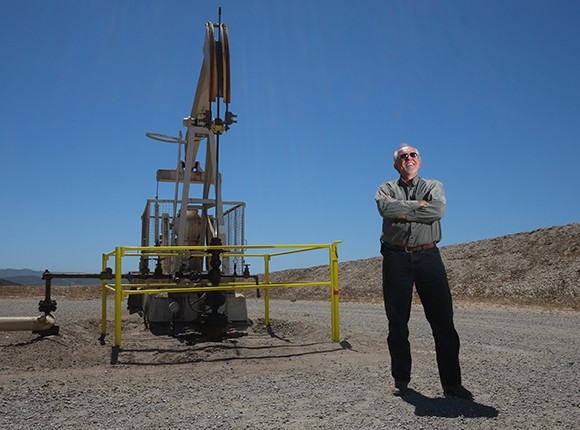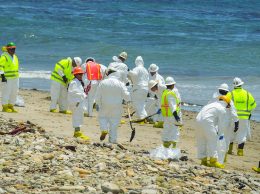Measure P puts future of oil drilling at stake
IN THIS ARTICLE
- Central Coast Topic
- Stephen Nellis Author
By Stephen Nellis Friday, September 5th, 2014

Bob Poole, Santa Maria Energy’s government and public affairs officer. (Stephen Nellis / Business Times file photo)
Measure P, a ballot initiative to ban so-called “high-intensity” oil operations in Santa Barbara County, has ticked off doom visions from both sides.
Supporters argue that without the measure, hundreds of new oil wells will take root and irrevocably foul the county’s air and water, hurting agriculture and tourism. Opponents call the measure a de-facto shutdown of the county’s petroleum industry that will cause hundreds of millions of dollars in lost revenues and cripple North Santa Barbara County’s economy.
But beyond the bluster, the reality is more complex. If the initiative passes and survives the inevitable legal challenges, both of which remain big ifs, the oil industry in Santa Barbara County will be forever changed.
The nascent oil boom that would see Santa Barbara County’s number of wells increase by up to 75 percent likely won’t happen. Unless oil operators find new approaches not covered under the initiative, the industry would, at best, freeze in place and slowly decline as Santa Barbara County’s reserves become tougher to produce with conventional methods.
What’s far less clear is what will become of current operations. Here’s a closer look at the facts and arguments on either side of Measure P.
Beyond fracking
Measure P would ban the use of techniques such as hydraulic fracturing, also known as fracking, and acid stimulation, which aren’t currently in use in the county. But it would also ban practices such as cyclic steaming, which is in use at about one-third of Santa Barbara County’s nearly 1,200 wells.
Moreover, almost 90 percent of 900 future wells are slated to use steaming or other techniques covered in the measure. The ballot initiative would sharply curtail the resurgence of energy development that has started to take place in recent years.
The measure does contain an exemption for existing operations. But that exemption is based on the concept of “vested rights.” The exact definition of that term as it applies to oil operations in Santa Barbara County is a question that energy producers are all but promising to take to court if the initiative passes.
Katie Davis, a volunteer with Santa Barbara Water Guardians, the group that worked to put the measure on the ballot, said that steam injection still involves the use of some chemicals that can be harmful. She also said that even though other techniques in the measure aren’t currently used, that doesn’t mean they won’t be tapped in the future. She contends that the “industry shutdown” argument is a distraction from the environmental issues at play.
“It’s understandable that the opposition doesn’t want to make this about fracking or acidizing or whether putting hydrochloric acid down wells is a good idea,” she said. “The problem with that argument is that the measure has a specific exemption for anybody with vested rights in a high-intensity petroleum operation.”
Jim Byrne, communications director for No On P, which is backed by several large oil operators in the county, said the measure amounts to a shutdown because it could block companies from obtaining permits for routine maintenance. The county’s own impartial staff analysis noted that all wells in the county would require techniques listed under the measure at some point during the life of the well.
“In California, in order to operate under vested rights, you need all the discretionary permits. Well, this measure bans the issuance of those permits, so it’s a Catch 22,” Byrne said.
What’s not in much dispute is that Santa Maria Energy likely won’t execute its project. Santa Maria Energy won approval for 136 wells last year, but it hasn’t yet secured specific building permits and started construction.
“If we don’t get the permits and the authorization to construct by Nov. 4, the project would have no vested rights,” said spokesman Bob Poole. “Clearly, with where we are, this measure would put us out of business.”
Vested rights
Caught in the middle of the fight between oil operators and environmental groups are county regulators, who will be bound to follow the results of the initiative. County officials are working to put into place a process for oil companies to apply for and obtain exemptions from the measure before election day comes in an effort to minimize court battles that might ensue.
The trickiest question will be that of vested rights under California state law. The definition of vesting for oil projects in the county could come down to a case-by-case basis fought in court, said Kevin Drude, deputy director of the Santa Barbara County Planning Department Energy Division.
“The county doesn’t have any criteria for vesting. We’ve never had to do it,” he said. “We’re bound by the language of the initiative not to use any other interpretations but what it says.”
Supporters of the measure say that companies will be able to continue existing activities. But oil companies say they believe the initiative curtails their rights and have hinted they will go to court to contest the point.
“Measure P has serious legal deficiencies including state law preemption, and … counsel have asserted that if Measure P is adopted, it would be a taking of mineral rights and other property interests and as a result the county will be subject to claims for compensation under the United States and California constitutions,” Pacific Coast Oil Trust, which owns North County producer Pacific Coast Energy Co., said in a note to investors.
Oil companies also argue that they pay taxes on proved reserves as soon as they’re granted initial permits. If they are unable to tap the reserves they’re being taxed for, oil companies have said, they will go to court for compensation.
“Every year, we pay tax on it until we produce it. The question comes to mind, ‘Would the county be responsible for reimbursing us for taxes paid on those reserves?’ ” said Poole of Santa Maria Energy.
So far, fracking bans in other states have failed to trigger any landmark legal rulings regarding mineral rights takings in favor of energy companies.
The only two certainties about Measure P so far seem to be that it will block the main avenue for the Santa Barbara County oil industry’s planned expansion in future years and that the fate of current operations is likely to be hotly contested.
“There’s the battle ground right there: What’s the determination or definition of vesting?” said the planning department’s Drude.
Related Articles
 Friday, September 16th, 2022
Friday, September 16th, 2022










